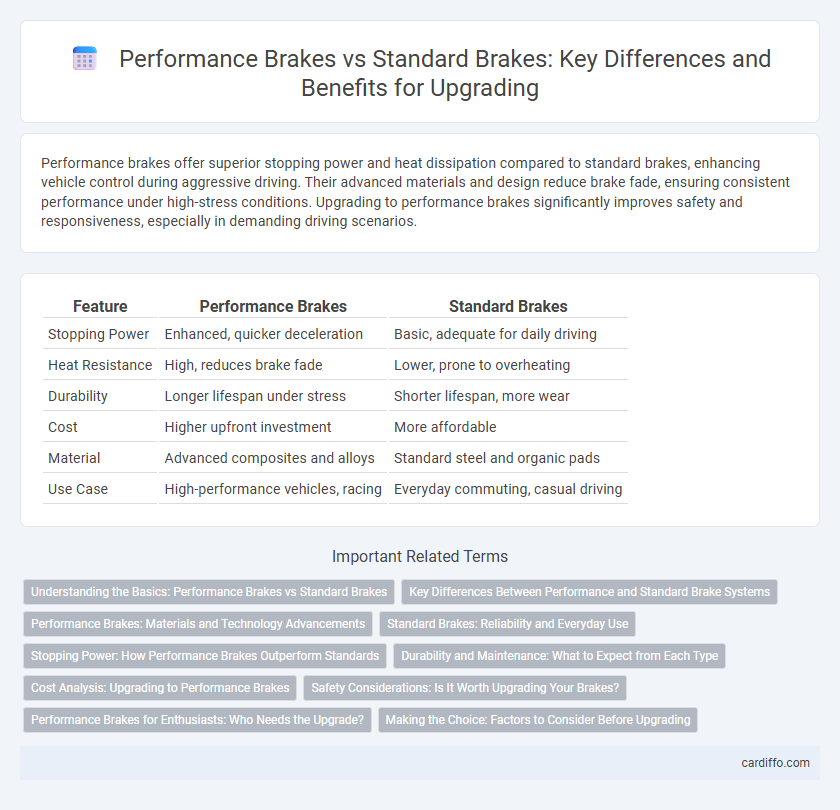Performance brakes offer superior stopping power and heat dissipation compared to standard brakes, enhancing vehicle control during aggressive driving. Their advanced materials and design reduce brake fade, ensuring consistent performance under high-stress conditions. Upgrading to performance brakes significantly improves safety and responsiveness, especially in demanding driving scenarios.
Table of Comparison
| Feature | Performance Brakes | Standard Brakes |
|---|---|---|
| Stopping Power | Enhanced, quicker deceleration | Basic, adequate for daily driving |
| Heat Resistance | High, reduces brake fade | Lower, prone to overheating |
| Durability | Longer lifespan under stress | Shorter lifespan, more wear |
| Cost | Higher upfront investment | More affordable |
| Material | Advanced composites and alloys | Standard steel and organic pads |
| Use Case | High-performance vehicles, racing | Everyday commuting, casual driving |
Understanding the Basics: Performance Brakes vs Standard Brakes
Performance brakes provide enhanced stopping power and heat dissipation compared to standard brakes, making them ideal for high-speed or aggressive driving conditions. They typically feature larger rotors, multi-piston calipers, and high-performance brake pads that improve responsiveness and reduce brake fade. Standard brakes are designed for everyday driving, offering reliable braking performance with lower costs and maintenance requirements.
Key Differences Between Performance and Standard Brake Systems
Performance brakes feature larger rotors and multi-piston calipers that provide superior stopping power and heat dissipation compared to standard brakes. They utilize high-friction brake pads and enhanced ventilation to reduce brake fade during aggressive driving or high-speed conditions. Standard brake systems are designed for everyday driving with simpler components, offering reliable but less aggressive braking performance.
Performance Brakes: Materials and Technology Advancements
Performance brakes utilize advanced materials like carbon-ceramic composites and high-carbon alloys, significantly enhancing heat dissipation and reducing brake fade compared to standard brakes. These brakes incorporate sophisticated technologies such as multi-piston calipers and ventilated, slotted rotors that improve stopping power and durability under extreme conditions. Innovative coatings and friction materials also increase resistance to wear, providing consistent brake performance and longer service life.
Standard Brakes: Reliability and Everyday Use
Standard brakes provide consistent reliability and are designed for everyday driving conditions, ensuring safe stopping power in typical traffic and weather scenarios. Their durable components require minimal maintenance, offering long-lasting performance that meets the demands of routine commute and city driving. Standard brakes prioritize stability and predictable response, making them ideal for drivers who value dependable braking without the need for high-performance features.
Stopping Power: How Performance Brakes Outperform Standards
Performance brakes deliver significantly enhanced stopping power compared to standard brakes, utilizing advanced materials like carbon-ceramic or high-performance ceramic composites. These materials increase friction and heat dissipation, resulting in shorter stopping distances and improved brake fade resistance under high stress. The superior design and construction of performance brakes provide reliable, consistent braking force essential for high-speed or aggressive driving conditions.
Durability and Maintenance: What to Expect from Each Type
Performance brakes typically feature advanced materials like carbon-ceramic composites, resulting in enhanced durability under extreme conditions compared to standard brakes that use conventional cast iron. Maintenance for performance brakes often requires specialized knowledge and higher costs due to their unique components, whereas standard brakes generally have lower maintenance expenses and easier part replacements. Expect performance brakes to offer superior longevity and heat resistance but anticipate more rigorous upkeep relative to standard braking systems.
Cost Analysis: Upgrading to Performance Brakes
Upgrading to performance brakes typically involves higher initial costs compared to standard brakes due to advanced materials like carbon-ceramic or high-grade alloys, which provide superior heat dissipation and stopping power. Over time, performance brakes can reduce maintenance expenses and improve safety, potentially offsetting the upfront investment through longer pad life and decreased rotor wear. Evaluating cost-effectiveness requires considering vehicle usage intensity, with performance brakes offering the best value for high-performance or frequent braking scenarios.
Safety Considerations: Is It Worth Upgrading Your Brakes?
Performance brakes offer enhanced stopping power, reduced fade, and greater heat dissipation compared to standard brakes, significantly improving vehicle safety during high-speed or emergency braking situations. Upgrading to performance brakes can decrease stopping distances and maintain consistent brake performance under heavy use, reducing the risk of accidents caused by brake failure or overheating. Investing in performance brakes is particularly beneficial for drivers who frequently navigate challenging driving conditions, tow heavy loads, or engage in spirited driving, making safety improvements well worth the cost.
Performance Brakes for Enthusiasts: Who Needs the Upgrade?
Performance brakes offer enhanced stopping power and heat dissipation compared to standard brakes, making them ideal for enthusiasts who engage in aggressive driving or track days. These upgraded braking systems typically feature larger rotors, multi-piston calipers, and high-friction brake pads, providing superior control and reduced brake fade during high-stress conditions. Enthusiasts seeking improved safety, responsiveness, and overall driving experience benefit most from investing in performance brake upgrades.
Making the Choice: Factors to Consider Before Upgrading
Performance brakes offer enhanced stopping power, heat dissipation, and durability compared to standard brakes, making them ideal for aggressive driving and high-speed conditions. Key factors to consider before upgrading include vehicle type, daily driving habits, and compatibility with existing brake systems to ensure optimal safety and performance. Budget constraints and maintenance requirements also play a critical role in determining whether performance brakes are a practical investment over standard braking components.
Performance brakes vs standard brakes Infographic

 cardiffo.com
cardiffo.com